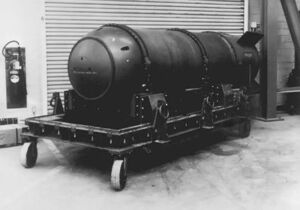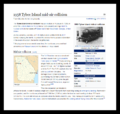1958 Tybee Island mid-air collision (nonfiction): Difference between revisions
No edit summary |
No edit summary |
||
| Line 1: | Line 1: | ||
[[File:Mk15_nuclear_bomb.jpg|thumb|A Mark 15 nuclear bomb of the type lost when jettisoned after the collision.]]The '''Tybee Island B-47 crash''' was an incident on February 5, 1958, in which the United States Air Force lost a 7,600-pound (3,400 kg) Mark 15 nuclear bomb in the waters off Tybee Island near Savannah, Georgia, United States. | [[File:Mk15_nuclear_bomb.jpg|thumb|A Mark 15 nuclear bomb of the type lost when jettisoned after the collision.]]The '''Tybee Island B-47 crash''' was an incident on February 5, 1958, in which the United States Air Force lost a 7,600-pound (3,400 kg) Mark 15 nuclear bomb in the waters off Tybee Island near Savannah, Georgia, United States. | ||
== Description == | |||
During a practice exercise, an F-86 fighter plane collided with the B-47 bomber carrying the bomb. To protect the aircrew from a possible detonation in the event of a crash, the bomb was jettisoned. | During a practice exercise, an F-86 fighter plane collided with the B-47 bomber carrying the bomb. To protect the aircrew from a possible detonation in the event of a crash, the bomb was jettisoned. | ||
| Line 6: | Line 8: | ||
Based on a hydrologic survey, the bomb was thought by the Department of Energy to lie buried under 5 to 15 feet (2 to 5 m) of silt at the bottom of Wassaw Sound. | Based on a hydrologic survey, the bomb was thought by the Department of Energy to lie buried under 5 to 15 feet (2 to 5 m) of silt at the bottom of Wassaw Sound. | ||
== Commentary == | |||
<blockquote> | |||
I am pretty sure it won't boom. But it will release radiation when the containment rusts through. That appears to not have happened yet, per Wikipedia: | |||
As of 2007, no undue levels of unnatural radioactive contamination have been detected in the regional Upper Floridan aquifer by the Georgia Department of Natural Resources (over and above the already high levels thought to be due to monazite, a locally occurring mineral that is naturally radioactive). | |||
—But if humanity survives this century we should probably think about recovering the bomb before it bleeds out. | |||
</blockquote> | |||
== In the News == | == In the News == | ||
Revision as of 08:09, 5 February 2021
The Tybee Island B-47 crash was an incident on February 5, 1958, in which the United States Air Force lost a 7,600-pound (3,400 kg) Mark 15 nuclear bomb in the waters off Tybee Island near Savannah, Georgia, United States.
Description
During a practice exercise, an F-86 fighter plane collided with the B-47 bomber carrying the bomb. To protect the aircrew from a possible detonation in the event of a crash, the bomb was jettisoned.
Starting on February 6, 1958, the Air Force 2700th Explosive Ordnance Disposal Squadron and 100 Navy personnel equipped with hand held sonar and galvanic drag and cable sweeps mounted a search. On April 16, the military announced the search had been unsuccessful.
Based on a hydrologic survey, the bomb was thought by the Department of Energy to lie buried under 5 to 15 feet (2 to 5 m) of silt at the bottom of Wassaw Sound.
Commentary
I am pretty sure it won't boom. But it will release radiation when the containment rusts through. That appears to not have happened yet, per Wikipedia:
As of 2007, no undue levels of unnatural radioactive contamination have been detected in the regional Upper Floridan aquifer by the Georgia Department of Natural Resources (over and above the already high levels thought to be due to monazite, a locally occurring mineral that is naturally radioactive).
—But if humanity survives this century we should probably think about recovering the bomb before it bleeds out.
In the News
Fiction cross-reference
Nonfiction cross-reference
External links
- 1958 Tybee Island mid-air collision @ Wikipedia

